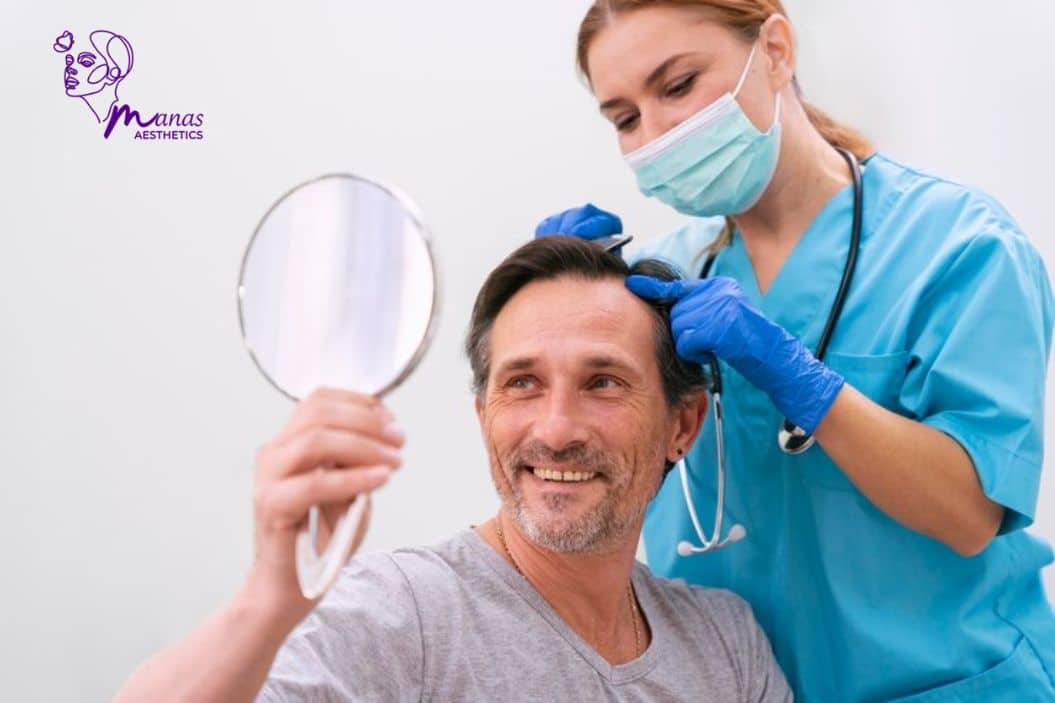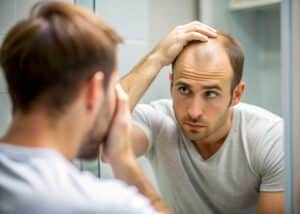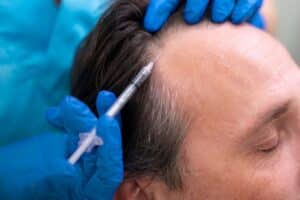Hair loss is a common concern for both men and women, affecting confidence and self-esteem. With advancements in medical technology, Platelet-Rich Plasma (PRP) hair treatment has emerged as a popular solution for hair restoration. But is PRP truly effective? Before considering this treatment, it’s essential to understand the facts about its success rate, how it works, and whether it’s the right option for you. In this blog, we’ll explore the science behind PRP, examine its benefits and limitations, and provide insights to help you make an informed decision.
What Causes Hair Loss?
Hair loss can be triggered by a variety of factors, both genetic and environmental.
Genetics: Hereditary factors, known as androgenetic alopecia, are a primary cause affecting both men and women.
Hormonal Changes: Fluctuations during pregnancy, menopause, or thyroid disorders can lead to hair thinning.
Nutritional Deficiencies: Lack of essential vitamins and minerals, such as iron, can weaken hair follicles.
Stress: Emotional or physical stress can trigger temporary hair loss.
Medical Conditions: Conditions like alopecia areata or autoimmune diseases may result in hair loss.
Medications: Certain medications can have side effects that include hair shedding.
Environmental Factors: Over-styling, heat damage, and exposure to harsh chemicals can contribute to hair breakage and thinning. Understanding these causes is crucial for determining the most effective treatment options for hair loss.
When to See a Professional?
Knowing when to seek professional help for hair loss is important to address the issue promptly and effectively. Here are signs that indicate it’s time to consult a healthcare provider or a hair specialist:
Sudden or Severe Hair Loss:
If you notice a rapid or significant increase in hair shedding or thinning, it’s advisable to seek medical advice.
Hair Thinning at a Young Age:
Hair loss that starts early in life, especially before the age of 20, may indicate underlying medical conditions that require evaluation.
Visible Bald Patches or Receding Hairline:
These signs could indicate conditions like alopecia areata or androgenetic alopecia that may benefit from professional diagnosis and treatment.
Scalp Conditions:
Persistent itching, scaling, or inflammation on the scalp could be related to conditions affecting hair health.
Hair Loss Post-Pregnancy or Illness:
Significant hair shedding after pregnancy or illness may be temporary but consulting with a healthcare provider can provide reassurance and guidance.
Lifestyle Factors:
If your hair loss is linked to recent changes in diet, medications, or lifestyle habits, a healthcare provider can offer advice on mitigating these effects.
Seeking professional advice early can help determine the cause of hair loss and explore appropriate hair treatment options tailored to your needs.
Introducing PRP Hair Treatment
PRP Hair Treatment is an innovative procedure used to promote hair growth and improve hair thickness in individuals experiencing hair loss or thinning. Platelet-Rich Plasma (PRP) therapy harnesses the body’s natural regenerative abilities. Often referred to as “vampire” treatments, PRP uses your own plasma to enhance scalp circulation and promote hair regrowth. Many individuals experience significant improvements after just three to five sessions.
Platelets in the blood play a crucial role in cell growth and regeneration. In PRP therapy, these platelets are concentrated up to five times more than in regular blood. This high concentration enables them to penetrate deep into the hair follicles, where they stimulate dermal papilla cells—an essential component for hair growth.
How PRP Hair Treatment Works
Here’s a detailed look at how PRP hair treatment works:
Blood Collection:
The process begins with a small amount of blood drawn from your arm, similar to a standard blood test.
Centrifugation: The collected blood is then placed in a centrifuge machine. This machine spins at high speeds, separating the blood into its different components: red blood cells, white blood cells, plasma, and platelets.
Isolation of PRP:
The centrifuge separates the platelet-rich plasma (PRP) from the rest of the blood components. PRP contains a higher concentration of platelets than normal blood, along with various growth factors essential for tissue repair and regeneration.
Preparation for Injection:
Once isolated, the PRP is prepared for injection. Sometimes, an activator like calcium chloride may be added to enhance the growth factor release from the platelets.
Injection into the Scalp:
Using a fine needle, the prepared PRP is injected directly into the scalp at the level of the hair follicles. This process targets areas where hair thinning or loss has occurred.
Mechanism of Action
Platelets and Growth Factors: Platelets are crucial for wound healing and tissue repair due to their rich reservoir of growth factors. When injected into the scalp, PRP stimulates the growth of hair follicles by increasing blood supply to the follicles and promoting the proliferation of dermal papilla cells, which play a key role in hair growth.
Stimulation of Stem Cells: PRP also activates stem cells in the hair follicle bulge area, which can lead to new hair growth and thicker, healthier hair strands.
PRP Hair Treatment Benefits and Results
PRP Hair Treatment offers several benefits and can yield promising results for individuals struggling with hair loss or thinning. Here’s what you can expect from PRP hair treatment:
Benefits of PRP Hair Treatment
Natural Regenerative Power:
PRP harnesses the body’s own healing mechanisms, using your own blood components to stimulate hair follicle activity and promote hair growth.
Non-Surgical and Minimally Invasive:
PRP injections are minimally invasive and typically do not require downtime, making it a convenient option for many individuals.
Improved Hair Thickness and Density:
By enhancing scalp circulation and stimulating dermal papilla cells, PRP can lead to thicker, denser hair over time.
Safe and Well-Tolerated:
Since PRP uses your own blood, there is minimal risk of allergic reactions or rejection.
Customizable Treatment Plans:
PRP hair treatment plans can be tailored to individual needs, ensuring targeted therapy based on the severity of hair loss and personal goals.
Results of PRP Treatment
Visible Hair Growth:
Many patients experience noticeable hair growth and increased hair volume after a series of PRP sessions.
Reduced Hair Shedding:
PRP therapy can help minimize excessive hair shedding, leading to improved hair retention and overall hair health.
Enhanced Hair Quality:
Patients often report that their hair becomes stronger, shinier, and more resilient after undergoing PRP hair treatment.
Gradual Improvement:
While results may vary among individuals, significant improvements in hair texture and density are typically seen within a few months of starting PRP therapy.
Busting PRP Therapy Myths
Platelet-Rich Plasma (PRP) therapy has gained popularity for its potential to stimulate hair growth and improve hair health. However, several myths and misconceptions surround this treatment. Let’s debunk some common myths about PRP therapy:
1.Myth: PRP Therapy is Painful
Fact: PRP therapy involves minimal discomfort. Before injection, a topical numbing cream is often applied to the scalp to minimize any potential discomfort. Most patients tolerate the procedure well with minimal pain during and after PRP Hair Treatment.
2. Myth: PRP Therapy Provides Immediate Results
Fact: PRP therapy requires multiple sessions for optimal results. While some patients may see improvements early on, significant hair regrowth and thickening usually occur gradually over several months as the hair follicles respond to the treatment.
3. Myth: PRP Therapy is Unsafe
Fact: PRP therapy is considered safe when performed by a trained healthcare professional. Since it uses the patient’s own blood, the risk of allergic reactions or infections is minimal.
Takeaways
PRP hair treatment shows promising potential in addressing hair loss through its natural regenerative approach. By harnessing the body’s own healing abilities with platelet-rich plasma, PRP therapy aims to stimulate hair follicles, promote hair growth, and enhance overall hair health. While individual results may vary, many individuals experience positive outcomes such as improved hair thickness and reduced shedding over multiple treatment sessions.
If you’re considering PRP therapy, we encourage you to explore trusted clinics like Manas Aesthetics. At Manas Aesthetics, we specialize in personalized PRP treatments tailored to your specific needs. Our dedicated team ensures you receive top-quality care and achieve optimal results in a welcoming environment.
Take the first step toward healthier, fuller hair today. Schedule a consultation at Manas Aesthetics and discover how PRP therapy can transform your hair and enhance your quality of life.



